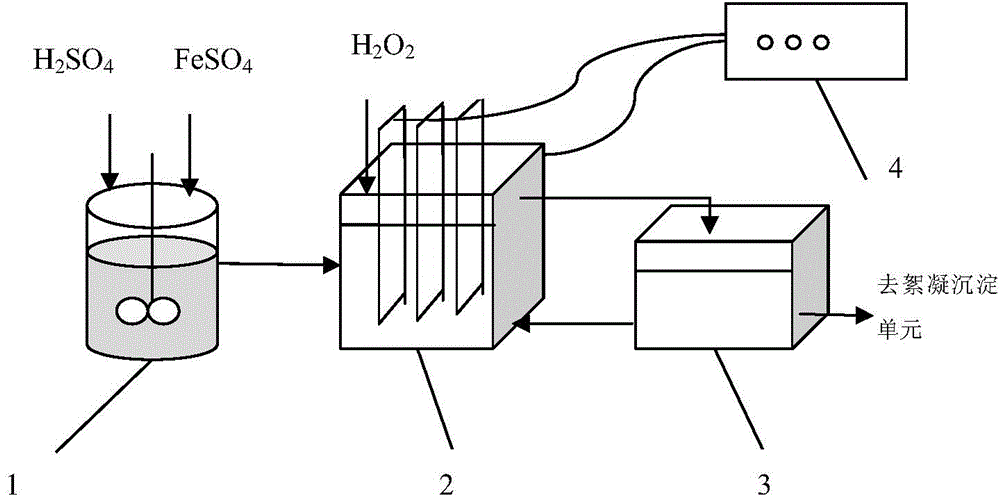Pretreatment method of nonionic surfactant wastewater
A non-ionic surface and active agent technology, applied in water/sewage treatment, water/sewage multi-stage treatment, water/sludge/sewage treatment, etc., can solve the problem of increasing the concentration of pollutants, unsatisfactory treatment effect, and toxicity and other issues to achieve the effect of high processing efficiency
- Summary
- Abstract
- Description
- Claims
- Application Information
AI Technical Summary
Problems solved by technology
Method used
Image
Examples
Embodiment 1
[0032] The measured COD value of a simulated wastewater is 21782mg / L, the pH value is adjusted to 2.0, the FeSO4 addition amount is 600mg / L, and the H 2 o 2 The dosage is 75mg / L, the input current is set to 19.2A, the internal circulation ratio is set to 1:1, the residence time is 30min, the measured COD value of the effluent is 10073mg / L, and the removal rate is 53.8%.
Embodiment 2
[0034] The measured COD value of a simulated wastewater is 11036mg / L, the pH value is adjusted to 2.5, the FeSO4 addition amount is 500mg / L, and the H 2 o 2 The dosage is 30mg / L, the input current is set to 9.7A, the internal circulation ratio is set to 1:1, the residence time is 60min, the measured COD value of the effluent is 2106mg / L, and the removal rate is 80.9%.
Embodiment 3
[0036] The measured COD value of a simulated wastewater is 5367mg / L, the pH value is adjusted to 3.0, the FeSO4 addition amount is 400mg / L, and the H 2 o 2 The dosage is 7.5mg / L, the input current is set to 9.7A, the internal circulation ratio is set to 1:1, the residence time is 60min, the measured COD value of the effluent is 2553mg / L, and the removal rate is 52.4%.
PUM
 Login to View More
Login to View More Abstract
Description
Claims
Application Information
 Login to View More
Login to View More - R&D
- Intellectual Property
- Life Sciences
- Materials
- Tech Scout
- Unparalleled Data Quality
- Higher Quality Content
- 60% Fewer Hallucinations
Browse by: Latest US Patents, China's latest patents, Technical Efficacy Thesaurus, Application Domain, Technology Topic, Popular Technical Reports.
© 2025 PatSnap. All rights reserved.Legal|Privacy policy|Modern Slavery Act Transparency Statement|Sitemap|About US| Contact US: help@patsnap.com

